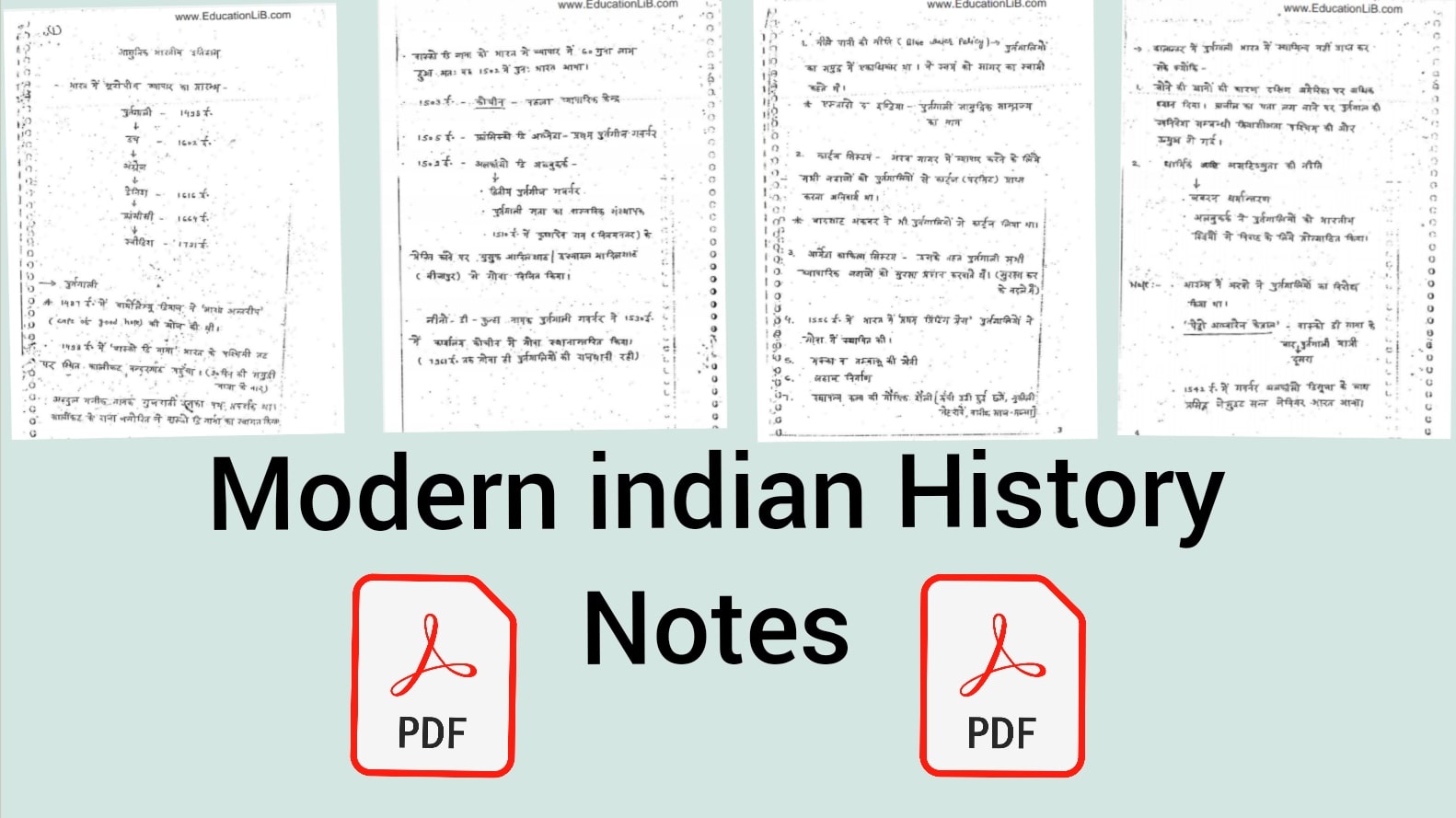Modern History UPSC Notes in Hindi
Modern History Notes: Modern Indian History is useful for all competitive exams, therefore all the candidates preparing for competitive exams should read Modern Indian History thoroughly. Education Lib has provided you complete notes of Modern Indian History in a single PDF. Modern Indian History Notes have been prepared in Hindi medium. The language style of these notes is very simple.
Modern Indian History Notes will be useful to you in every competitive exam, so you must study these notes. To download the PDF of these notes, you can download it by clicking on the download PDF button below.
NCERT Notes for History of Modern India
Indian history and culture are extensively covered in both the UPSC Civil Services Exam’s preliminary and main exams. It is an essential part of the UPSC civil service curriculum, particularly for the UPSC preliminary exam. At least two or three questions from this subject are included in the IAS preliminary exam each year.
Students should study Modern Indian history if they want to comprehend the real nature of the past and the types of obstacles that have prevented India from progressing as a nation. Let us tell you that these notes of modern Indian history have been prepared from NCERT books.
Modern History Notes Topic
- भारत में यूरोपीय व्यापार का प्रारम्भ
- पुर्तगाली, डच, अंग्रेज, डेनिश, फ़्रांसीसी, स्वीडीश
- आंग्ला-फ़्रांसीसी संघर्ष/कर्नाटक युद्ध
- उत्तरकालीन मुग़ल शासक
- बंगाल
- मराठा
- आंग्ला-मैसूर संघर्ष
- पंजाब
- गवर्नर-जनरल
- बंगाल विभाजन
- 1857 का विद्रोह
- धार्मिक एवं समाज सुधार आंदोलन
- महिला शिक्षा
- भारतीय राष्ट्रीय आंदोलन का उदय एवं विकास
- ब्रिटिश शासन के प्रभाव
- काग्रेस की स्थापना से पूर्व स्थापित राजनीति संगठन
- कांग्रेस के महत्वपूर्ण अधिवेशन
- सेफ्टी वॉल्व सिद्धांत
- कांग्रेस के बारे में विभिन्न टिप्पनियां
- राष्ट्रीय आंदोलन का प्रथम चरण (1885-1905)
- राष्ट्रीय आंदोलन का द्वितीय चरण (1905-1919)मुस्लिम लीग की स्थापना
- 1911 ईस्वी का दिल्ली दरबार
- कामागाटामारू प्रकरण 1914 ई
- होमरुल आंदोलन
- राष्ट्रीय आंदोलन का तीसरा चरण (1919-1947)
- चम्पारण आंदोलन – 1917
- जलियावाला बाग़ हत्याकाण्ड (13 अप्रेल 1919)
- खिलाफत आंदोलन 1919-1920
- 1919 ई का भारत सरकार अधिनियम
- असहयोग आंदोलन
- नेहरू रिपोर्ट 1928
- 1929 लाहौर अधिवेशन
- गांधीजी का 11 सूत्री मांग पत्र
- सविनय अवज्ञा आंदोलन
- कराची अधिवेशन मार्च 1931
- गोलमेज सम्मलेन
- पूना समझौता 26 सितम्बर 1932
- भारत सरकार अधिनियम 1935
- 1937 ई के चुनाव
- व्यक्तिगत सत्यग्रह (दिल्ली चलो आंदोलन)
- अगस्त प्रस्ताव
- क्रिप्स प्रस्ताव 1942
- भारत छोड़ो आंदोलन
- C R फार्मूला
- वेबेल योजना 1945
- शिमला सम्मेलन 1945
- शाही नौ सेना विद्रोह
- केबिनट मिशन 1946
- एटली घोषणा
- माउन्टबेटन योजना
- भारतीय स्वतंत्रता अधिनियम 1947
- क्रांतिकारी आंदोलन का प्रथम चरण
- क्रांतिकारी आंदोलन का दूसरा चरण
- भारत में समयवादी आंदोलन
- आजाद हिंद फौज
- भारतीय इतिहास के विभिन्न किसान आंदोलन
Medium – Hindi
PDF File Size – 30MB
Total Page – 230
अन्य परीक्षाओं से संबंधित फ्री नोट्स प्राप्त करने के लिए यहाँ क्लिक करें।
FAQs
Q. What is the history of modern India?
Answer:- Modern Indian history can be termed as the history after 1850. A large part of modern Indian history was occupied by the British rule in India.
Q. When did the modern period begin?
Answer:- The modern period in India is considered to have begun in the mid-18th century, while in Europe it began in the 15th century.
Q. What should be read in modern history?
Answer:- It covers subjects including Gandhiji and his nonviolent philosophy, Nehru and his role in the Indian freedom movement, India’s freedom battle, and Independence Day. The freedom movement, Partition, the rule of Nehru and Gandhi, the Emergency, the Mandal Commission, and other subjects are covered in the curriculum for Modern Indian History.
Tags: History of Modern India, Modern History Notes